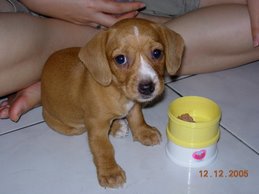Article From SubmitYOURArticle.com: 3 Tropical Freshwater Fish That Are Great For Your Aquarium - B to C
Three tropical freshwater aquarium fish you can
add to your aquarium are detailed here (Brown
Acara, Cardinal Tetra and Chocolate Gourami).
Information is provided on feeding, colors,
breeding, temperament and aquarium temperatures.
Brown Acara - Aequidens portalegrensis (Family:
Cichlidae)
The main body color of the adult is
reddish-brown, the scales are large and the fins
are greenish and marbled with a range of colors.
A horizontal line of dark colored bars runs from
the eye to near the tail at which there is a dark
area surrounded by yellow or green dots.
Although timid, it can grow to more than 15 cms
so you need to consider if it is ideal or not for
your community tank. The difference between the
sexes is subtle. The anal fin of the male is
longer and less rounder than that of the female
and the colors of the fins are less bright. After
mating the pair stay together for life which is a
particular feature of the species.
The breeding tank must have rocks and similar
stuff removed as the fish can be injured during
the vigorous courtship. The pair should be about
the same build and be fed on live food. Place a
piece of slate in the tank so eggs can be laid on
it and when the fry are hatched and able to swim
remove both the parents. Feed the fry on
infusoria, micro-worms and daphnids.
Cardinal Tetra - Cheirodon axelrodi (Family:
Characidae)
One of the most popular tetras and great for a
community aquarium as it is active and peaceful.
Slim, it grows up to about 7 cms, ideally should
be part of a small shoal and giving them live
food now and again will keep them fit and healthy.
From the mouth and eye to the tail runs a
reddish-brown coloration covering most of the
lower body. Above that runs a green fluorescent
band. The dorsal and anal fins have no color. The
male is less thicker in the body than the female.
This species is not easy to breed. Suitable pairs
are picked by observation and kept apart feeding
with live food to get them ready.
The female is placed in the breeding tank in the
morning and the male in the evening. The tank
will be thickly planted at one end with nylon
breeding mops scattered about. The next day
spawning should take place and semi-sticky eggs
will be placed in the breeding mops which are
then removed to a separate tank at the same
temperature. After five days left in darkness you
should find fry swimming about which can then be
fed on infusoria till they are ready for bigger
food such as micro-worms.
Chocolate Gourami - Sphaerichthys osphromenoides
(Family: Belontiidae)
Although it can be put in a community tank this
fish is quite susceptible to disease so be
warned. But once it gets through any illness and
gets used to the environment it is then quite
hardy. Its aquarium requirements are soft water,
a temperature of 26 to 30 degrees centigrade and
a densely planted area.
The body color is from dark brown to black and it
has several vertical silver white stripes of
different shape. The mouth shows tiny teeth and
the pelvic, dorsal and anal fins are black. As
bubble-nest breeders the eggs are produced by the
female after mating, the male puts them in his
mouth and blows them into the bubble nest he
previously built floating on the surface.
Remove the female after she lays the eggs. The
male looks after the eggs; he will replace eggs
that fall from the nest, he will maintain the
nest structure with additional bubbles and aerate
the eggs by swishing his tail near them. Remove
the male after the fry start swimming.
----------------------------------------------------
Paul Curran is webmaster at
Fresh-Water-Aquariums-Guide.com and provides a
care information system for fresh water
aquariums. Get your FREE E-Course on how to set
up and maintain a beautiful aquarium, have the
healthiest, happiest fish around AND learn more
about your tropical freshwater aquarium fish at
http://www.fresh-water-aquariums-guide.com/tropica
l-freshwater-aquarium-fish/
EasyPublish this article: http://submityourarticle.com/articles/easypublish.php?art_id=126343














.jpg)






.jpg)

0 comments:
Post a Comment